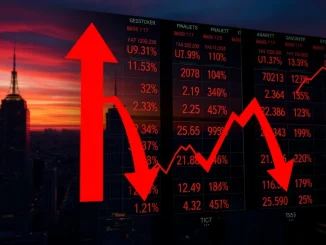
Buckle up, investors! The U.S. stock markets have started the day on a somber note, with all major indices dipping into the red right at the opening bell. Is this a minor tremor or the start of something bigger? For those watching the crypto space, traditional market movements often provide crucial signals. Let’s dive into what’s causing this stock market dip and what it could mean for your investments.
What’s Behind Today’s Stock Market Dip?
At the time of writing, the key U.S. stock market indices are showing the following declines:
- S&P 500: -0.09%
- NASDAQ: -0.31%
- Dow Jones: -0.17%
While these percentage drops might seem modest at first glance, they represent a collective sentiment shift in the market. Several factors could be contributing to this early downturn. Let’s break down some potential reasons for this market volatility:
- Inflation Concerns: Lingering worries about persistent inflation continue to weigh on investor sentiment. Even though recent data has shown some cooling, the fear of further interest rate hikes by the Federal Reserve remains.
- Geopolitical Tensions: Global events and geopolitical uncertainties always cast a shadow over the markets. Any unexpected news on this front can trigger immediate market reactions.
- Earnings Season Anticipation: With earnings season on the horizon, investors are likely adopting a cautious stance. The upcoming financial reports from major companies will provide crucial insights into the health of the economy and corporate profitability.
- Profit Taking: After periods of gains, some investors might be taking profits, leading to a temporary pullback in prices.
Navigating Market Volatility: Key Insights for Investors
Market volatility is an inherent part of the investment landscape. Understanding how to navigate these periods is crucial, especially for cryptocurrency investors who are accustomed to even higher levels of price swings. Here are some actionable insights:
| Insight | Description |
|---|---|
| Stay Informed | Keep a close watch on market news and economic indicators. Understanding the factors driving market movements is the first step in making informed decisions. |
| Diversification is Key | A diversified portfolio across different asset classes can help mitigate risk during volatile periods. Don’t put all your eggs in one basket. |
| Long-Term Perspective | Remember that market dips are often temporary. Maintain a long-term investment perspective and avoid making impulsive decisions based on short-term fluctuations. |
| Dollar-Cost Averaging | Consider using dollar-cost averaging to invest gradually over time. This strategy can help reduce the impact of volatility on your overall investment. |
| Review Your Risk Tolerance | Market downturns are a good time to reassess your risk tolerance. Ensure your portfolio aligns with your comfort level and financial goals. |
Decoding Economic Uncertainty: What Does it Mean for You?
The current economic uncertainty reflected in the stock market opening is a complex puzzle with many pieces. It’s not just about the numbers flashing on the screen; it’s about the broader economic landscape and how it affects our financial well-being.
Factors Contributing to Economic Uncertainty:
- Global Economic Slowdown: Concerns about a potential global economic slowdown are persistent. International organizations are closely monitoring growth forecasts and potential recession risks.
- Supply Chain Disruptions: While improving, supply chain issues are still impacting various sectors, contributing to inflationary pressures and economic uncertainty.
- Central Bank Policies: The actions of central banks, particularly the Federal Reserve in the U.S., in managing inflation and interest rates play a significant role in shaping economic outlook.
- Energy Prices: Fluctuations in energy prices can have a ripple effect across the economy, impacting everything from transportation costs to consumer goods prices.
Dow Jones, S&P 500, and NASDAQ: A Closer Look at Index Performance
Let’s take a slightly closer look at the performance of the specific indices mentioned:
- Dow Jones Industrial Average: Representing 30 large, publicly owned companies based in the United States, the Dow Jones is often seen as a bellwether of the overall U.S. economy. Its 0.17% dip indicates a broad, albeit slight, negative sentiment among major industrial players.
- S&P 500: Considered a more comprehensive representation of the U.S. stock market, the S&P 500 tracks the stock performance of 500 of the largest publicly traded companies in the United States. A 0.09% decrease here suggests a slightly less pronounced, but still present, market hesitancy across a wider spectrum of companies.
- NASDAQ Composite: Heavily weighted towards technology stocks, the NASDAQ is often viewed as a gauge of the tech sector’s health. A larger dip of 0.31% in the NASDAQ could indicate some specific pressure on technology stocks, possibly due to growth stock valuations in a higher interest rate environment.
What’s Next After This Stock Market Dip?
Predicting the future of the stock market with certainty is impossible. However, understanding the current context and potential influencing factors is crucial. This initial stock market dip could be a temporary blip, or it could signal the beginning of a more sustained downward trend.
Keep an Eye On:
- Upcoming Economic Data Releases: Inflation figures, jobs reports, and GDP data will be critical in shaping market direction.
- Federal Reserve Statements: Any signals from the Fed regarding future monetary policy will be closely scrutinized.
- Corporate Earnings Reports: The upcoming earnings season will provide tangible insights into company performance and future outlooks.
- Global News Flow: Geopolitical events and international economic developments can quickly impact market sentiment.
In Conclusion: Navigating Uncertainty with Diligence
Today’s lower opening in the U.S. stock markets serves as a reminder of the ever-present market volatility and economic uncertainty. While the initial declines are modest, they underscore the need for investors to remain vigilant, informed, and adaptable. Whether you are invested in traditional stocks or the dynamic world of cryptocurrencies, understanding the interplay of market forces is essential for making sound investment decisions. Stay tuned for further updates and in-depth analysis as the market day unfolds.



